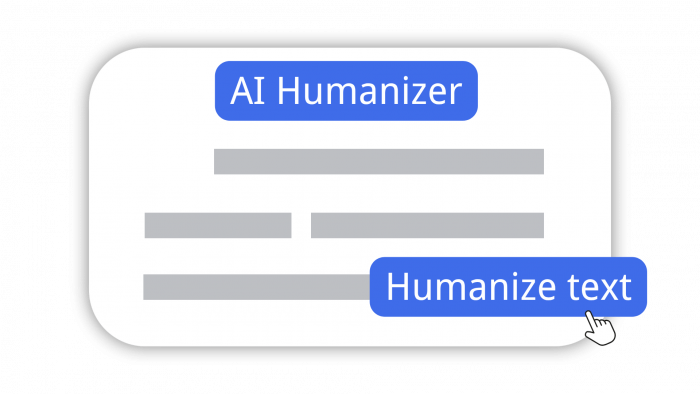In today’s fast-paced digital world, AI-generated content is a game-changer for students, writers, and businesses. However, AI text often lacks the natural flow and emotional depth of human writing, making it detectable by tools like Turnitin, GPTZero, or Originality.ai.
That’s where an AI humanizer comes in! This guide will walk you through how to transform robotic AI text into engaging, human-like content that bypasses AI detectors and resonates with your audience.
Why Humanize AI Text?

AI tools like ChatGPT, Claude, or Gemini produce efficient and consistent content, but they often lack the nuance, creativity, and relatability of human writing. Here’s why humanizing AI text is essential:
- Bypass AI Detectors: Ensure your content passes strict detection tools used in academic, professional, and publishing settings.
- Enhance Engagement: Humanized text connects emotionally with readers, making it more compelling and authentic.
- Avoid SEO Penalties: Google may flag AI-generated content, impacting your website’s ranking. Humanized text maintains keyword richness while appearing natural.
- Save Time: Transform AI drafts into polished, human-like content in seconds, reducing manual editing efforts.
Whether you’re a student submitting an essay, a content creator crafting blog posts, or a business professional producing marketing copy, humanizing AI text ensures your work stands out as authentic and professional.
How to Humanize AI Text: A Step-by-Step Guide
Transforming AI-generated content into human-like text is simple with the right approach. Follow these steps to create undetectable, engaging content:
- Choose Your AI-Generated Text: Start with content generated by tools like ChatGPT, Claude, or Jasper. Copy the text you want to humanize.
- Select a Reliable AI Humanizer: Use a trusted tool like BypassGPT, designed to rewrite AI text with natural language patterns. Visit their website or platform.
- Paste Your Text: Input your AI-generated content into the humanizer’s text box.
- Customize the Output (Optional): Some tools allow you to adjust tone (e.g., professional, casual, academic) or rewrite depth (minimal to extensive changes).
- Click “Humanize”: Press the humanize button to let the tool analyze and rewrite your text, mimicking human writing styles.
- Review the Output: Check the humanized text for fluency, coherence, and alignment with your original intent. Edit if needed.
- Verify with AI Detectors: Run the output through detectors like GPTZero or Turnitin to confirm it’s undetectable as AI-generated.
- Use Your Content: Copy the humanized text and use it for your blog, essay, social media post, or marketing campaign.
With these steps, your AI-generated content will read like it was crafted by a human, bypassing detection and engaging your audience.
Real-World Applications of AI Humanizers
AI humanizers are versatile tools that benefit a wide range of users. Here are some practical use cases:
- Students: Transform AI-generated essays or research papers into authentic, plagiarism-free content that passes academic integrity checks.
- Content Creators: Create SEO-friendly blog posts or social media captions that sound natural and avoid Google penalties.
- Business Professionals: Produce engaging marketing copy, emails, or reports that resonate with clients and maintain brand authenticity.
- Web Developers: Ensure website content is human-like, improving user engagement and search engine rankings.
- Creative Writers: Add emotional depth to AI-generated stories or scripts, making them more relatable and captivating.
For example, a student might use an AI humanizer to refine a ChatGPT-generated essay, ensuring it passes Turnitin’s checks while maintaining academic tone. Similarly, a marketer could humanize AI-crafted product descriptions to boost conversions without triggering spam filters.
Tips for Using AI Humanizers Effectively
To get the best results from an AI humanizer, keep these tips in mind:
- Choose the Right Tone: Match the tone to your audience—academic for essays, conversational for blogs, or professional for business documents.
- Preserve Key Information: Ensure the humanized text retains the original meaning and critical details.
- Check for Plagiarism: Use tools like Copyleaks or Originality.ai to confirm the output is 100% unique.
- Test with Multiple Detectors: Verify the humanized text against various AI detectors to ensure it’s undetectable.
- Edit for Perfection: While humanizers produce natural text, a quick review can add a personal touch or fix minor issues.
Why Choose a Tool Like ShadowGpt?
ShadowGpt stands out as a leading AI humanizer due to its advanced algorithms and user-friendly features. Here’s what makes it effective:
- Advanced Technology: Trained on millions of human-written and AI-generated texts, it identifies and rewrites robotic patterns with precision.
- Error-Free Output: Eliminates grammar, syntax, or punctuation mistakes, ensuring polished, professional content.
- SEO Optimization: Maintains keyword richness for better search engine rankings while avoiding penalties.
- Multi-Language Support: Humanizes text in over 100 languages, making it ideal for global users.
- Free Trial: Test the tool without cost, allowing you to experience its capabilities risk-free.
By using a tool like BypassGPT, you can transform AI text into content that’s indistinguishable from human writing, saving time and boosting quality.
The Future of Content Creation
As AI tools become more prevalent, the need to humanize AI-generated text will only grow. Whether you’re aiming to bypass AI detectors, improve readability, or enhance audience engagement, an AI humanizer is your key to success. By combining the efficiency of AI with the authenticity of human writing, you can create content that’s both impactful and undetectable.
Post Comment
Be the first to post comment!


